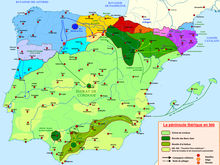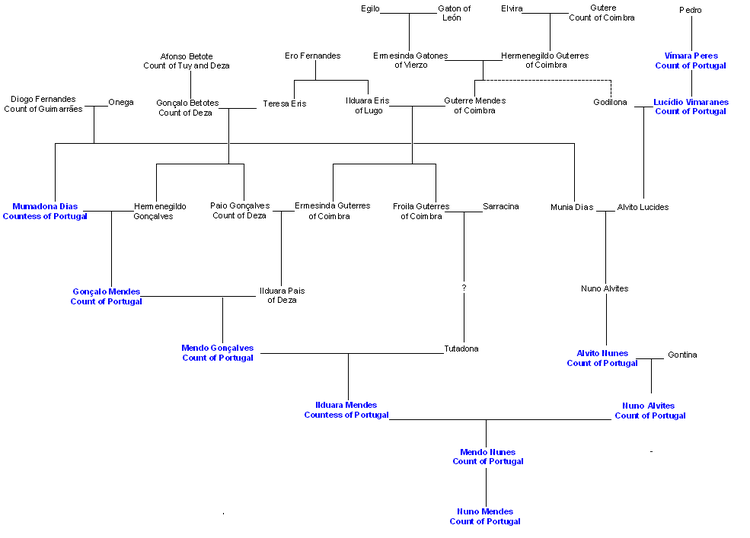County of Portugal
County of Portugal Comtato Portugallense Comtato de Portugalle ( Latin ) | |||||||||||||||
|---|---|---|---|---|---|---|---|---|---|---|---|---|---|---|---|
| 868–1071 1096–1139 | |||||||||||||||
Feudal monarchy | |||||||||||||||
| Count of Portucale | |||||||||||||||
• 868–873 | Vímara Peres (first of the first county, from the House of Vímara) | ||||||||||||||
• 1050–1071 | Nuno II Mendes (last of the first county, from the House of Vímara; Annexation to the Kingdom of Galicia | ||||||||||||||
• 1096–1112 | Henry (first of second county, from the house of Burgundy) | ||||||||||||||
• 1112–1139 | Afonso Henriques (last of the second county) | ||||||||||||||
| History | |||||||||||||||
• Established | 868 | ||||||||||||||
| 1139 | |||||||||||||||
| ISO 3166 code | PT | ||||||||||||||
| |||||||||||||||
| Today part of | Portugal Spain | ||||||||||||||
The County of Portugal (
First county

The history of the county of Portugal is traditionally dated from the in 1064.
The leaders of the first county of Portugal reached the height of their power in the late 10th century, when Count Gonzalo Menéndez may have used the title magnus dux portucalensium ("grand duke of Portugal") and his son Menendo used the title dux magnus (grand duke). It could have been this Count Gonzalo who assassinated Sancho I of León after inviting the King to a banquet and offering him a poisoned apple.[2] Not all historians, however, believe that Gonzalo Menéndez was responsible for the king's death and some attribute the regicide to a contemporary count named Gonzalo Muñoz.[3]
In the late 960s Gonzalo's lands were ravaged by Vikings, and in 968, he fell out with king Ramiro III over the latter's refusal to fight the raiders. His son Menendo had close relations with Ramiro's rival and successor, Bermudo II, being made the king's alférez and tutor of his son, the future king Alfonso V. Following Alfonso's succession, Menendo would serve as regent for the boy king and married him to one of Menendo's daughters.
The county continued with varying degrees of autonomy within the Kingdom of León and, during brief periods of division, the
Second county


In 1093, Alfonso VI nominated his son-in-law
Count Henry continued the Reconquista in western Iberia and expanded his county's dominions. He was also involved in several intrigues inside the Leonese court together with his cousin Raymond and sister-in-law
Even then, between 1128 and 1139 he never used the title of king, but rather that of princeps or infante, which means, in fact, that he could not resolve on his own account, the issue of his political category; that is, he had to admit that it depended on the consent of Alfonso VII who was, in fact, the legitimate heir of Alfonso VI. Also, he never used the title of "count" which would place him in a clear position of dependence vis-à-vis the king of León and Castile. (translation)[11]
It was his triumph in the Battle of Ourique in 1139, which led to his proclamation as King of Portugal by his troops.[10] Finally in 1143, his nominal overlord Alfonso VII of León and Castile recognized the de facto independence of Portugal in the Treaty of Zamora.[12]
List of counts
First county ('House of Vímara')
- Vímara Peres (868–873)
- Lucídio Vimaranes (873–924)
- Hermenegildo González (c.924–c.950)
- Mumadona Dias (c.924–c.950)
- Gonzalo Menéndez (c.950–997), self-styled "Grand Duke of Portugal"
- Menendo González (997–1008)
- Alvito Nunes (1008–1015)
- Nuno Alvites (1017–1028)
- Ilduara Mendes (1017–1028, as regent for son)
- Mendo Nunes (1028–1050)
- Nuno Mendes (1050–1071)
- Family tree
Second county ('House of Burgundy')
See also
Notes
- ^ Recognized as "Queen of Portugal" in 1116 by Pope Paschal II, but forced to renounce the claimed independence in 1121, although she would continue to be styled "Queen" in later documents.
- ^ Proclaimed king by his troops in 1139, and recognized as independent by the king of León in 1143.[12] Portugal was acknowledged as an independent kingdom by Pope Alexander III in 1179.[13]
References
- ISBN 989-554-106-6
- ^ Abdurrahman Ali El-Hajji (1965), "Christian States in Northern Spain During the Umayyad Period (138–366 A.H./A.D. 755–976): The Borders of those States, their kings, Internal Relations; Its Influence on their Relations and Motives for their Diplomatic Relations with the Muslims," Islamic Quarterly, 9(1/2), 51; Roger Collins (1983), Early Medieval Spain: Unity in Diversity, 400–1000 (Macmillan), 242.
- ^ Mattoso 1982, pp. 22–23.
- ^ Barton 1997, p. 14.
- ^ Ferreira 2010, p. 23.
- ^ a b Serrão 1990, p. 145.
- ^ Serrão 1990, p. 147.
- ^ "Donation document of Soure Castle to the Knights Templar by Queen D.Teresa in 1126 ("Ego Regina Tarasia")". Arquivo Nacional da Torre do Tombo. 1126. Archived from the original on 24 November 2015.
- ^ "Donation document of the burg of Porto to Bishop Hugo by Queen D.Teresa in 1120". Câmara Municipal do Porto.
- ^ a b Mattoso 2014, pp. 166–172.
- ^ Mattoso 2014, p. 137.
- ^ a b Mattoso 2014, p. 212.
- ^ Mattoso 2014, p. 359.
Bibliography
- Barton, Simon (1997). The Aristocracy in Twelfth-Century León and Castile. Cambridge, England: Cambridge University Press. ISBN 978-0521-4972-75.
- Ferreira, João (2010), Histórias Rocambolescas da História de Portugal [Fantastic Stories of the History of Portugal] (in Portuguese) (6 ed.), Lisbon, Portugal: A Esfera dos Livros, ISBN 9789896267681
- ISBN 978-972-759-911-0.
- ISBN 9789726653035.
- Serrão, Joel (1990), Dicionário de História de Portugal (in Portuguese), vol. II Castanhoso-Fez, Porto, Portugal: Livraria Figueirinhas




